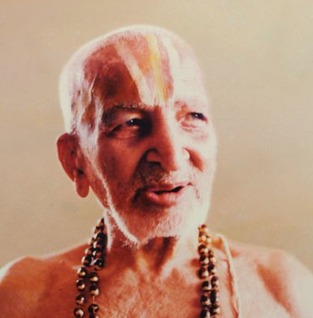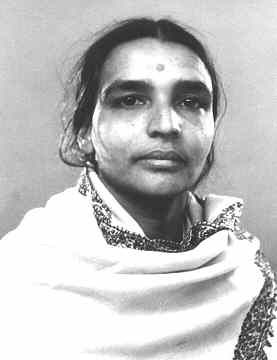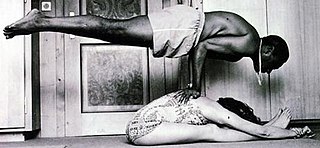
Iyengar Yoga, named after and developed by B. K. S. Iyengar, and described in his bestselling 1966 book Light on Yoga, is a form of yoga as exercise that has an emphasis on detail, precision and alignment in the performance of yoga postures (asanas).

K. Pattabhi Jois was an Indian yoga guru who developed and popularized the flowing style of yoga as exercise known as Ashtanga vinyasa yoga. In 1948, Jois established the Ashtanga Yoga Research Institute in Mysore, India. Pattabhi Jois is one of a short list of Indians instrumental in establishing modern yoga as exercise in the 20th century, along with B. K. S. Iyengar, another pupil of Krishnamacharya in Mysore. Jois sexually abused some of his yoga students by touching inappropriately during adjustments. Sharath Jois has publicly apologised for his grandfather's "improper adjustments".

Bellur Krishnamachar Sundararaja Iyengar was an Indian teacher of yoga and author. He is founder of the style of yoga as exercise, known as "Iyengar Yoga", and was considered one of the foremost yoga gurus in the world. He was the author of many books on yoga practice and philosophy including Light on Yoga, Light on Pranayama, Light on the Yoga Sutras of Patanjali, and Light on Life. Iyengar was one of the earliest students of Tirumalai Krishnamacharya, who is often referred to as "the father of modern yoga". He has been credited with popularizing yoga, first in India and then around the world.

Tirumalai Krishnamacharya was an Indian yoga teacher, ayurvedic healer and scholar. He is seen as one of the most important gurus of modern yoga, and is often called "Father of Modern Yoga" for his wide influence on the development of postural yoga. Like earlier pioneers influenced by physical culture such as Yogendra and Kuvalayananda, he contributed to the revival of hatha yoga.

Amrit Desai is a pioneer of yoga in the West, and one of the few remaining living yoga gurus who originally brought over the authentic teachings of yoga in the early 1960s. He is the creator of two brands of yoga, Kripalu Yoga and I AM Yoga, and is the founder of five yoga and health centers in the US. His yoga training programs have reached more than 40 countries worldwide and over 8,000 teachers have been certified.

Geeta S. Iyengar, the eldest daughter of Yogacharya B. K. S. Iyengar, was a yoga teacher credited with advancing yoga for women.

Vanda Scaravelli is known for her contribution to the practice of yoga in the West. She learnt yoga as an early student of two of Tirumalai Krishnamacharya's pupils, B. K. S. Iyengar who taught her the asanas, and T. K. V. Desikachar who taught her pranayama. Her style of yoga was developed with the help of her long-term students, the yoga teachers Diane Long and Esther Myers, who continued the evolution of Vanda's non-lineage yoga. Scaravelli asked her followers not to name any school of yoga after her; this has not prevented some yoga teachers from claiming to teach "Scaravelli-inspired yoga".

Yoga as exercise is a physical activity consisting mainly of postures, often connected by flowing sequences, sometimes accompanied by breathing exercises, and frequently ending with relaxation lying down or meditation. Yoga in this form has become familiar across the world, especially in the US and Europe. It is derived from medieval Haṭha yoga, which made use of similar postures, but it is generally simply called "yoga". Academics have given yoga as exercise a variety of names, including modern postural yoga and transnational anglophone yoga.
Anne Cushman is an American teacher of yoga as exercise and meditation, a writer on Mindful Yoga, and a novelist. Her novel Enlightenment for Idiots was named by Booklist as one of the top ten novels of 2008. Cushman has also been an editor for Yoga Journal and Tricycle: The Buddhist Review. She directs mentoring programs and multi-year meditation training for yoga teachers at the Spirit Rock Meditation Center, emphasizing the fusion of yoga and Buddhist meditation and highlighting their shared history and philosophy.

Modern yoga as exercise has often been taught by women to classes consisting mainly of women. This continued a tradition of gendered physical activity dating back to the early 20th century, with the Harmonic Gymnastics of Genevieve Stebbins in the US and Mary Bagot Stack in Britain. One of the pioneers of modern yoga, Indra Devi, a pupil of Krishnamacharya, popularised yoga among American women using her celebrity Hollywood clients as a lever.

Mindful Yoga or Mindfulness Yoga combines Buddhist-style mindfulness practice with yoga as exercise to provide a means of exercise that is also meditative and useful for reducing stress. Buddhism and Hinduism have since ancient times shared many aspects of philosophy and practice including mindfulness, understanding the suffering caused by an erroneous view of reality, and using concentrated and meditative states to address such suffering.
Donna Farhi is a yoga teacher and the author of five books on practicing and teaching yoga. She has been described as a yoga "superstar".
Frank Jude Boccio is a teacher and one of the originators of mindful yoga. He is known both for his teaching in centres across America, and for his 2004 book Mindfulness Yoga: The Awakened Union of Breath, Body and Mind, which describes a practice that combines yoga as exercise and Buddhist meditational practice.
Stephen Cope is a psychotherapist, Kripalu Yoga teacher, and author of several books on yoga and meditation. He is the founder of the Kripalu Institute for Extraordinary Living.

The history of yoga in the United States begins in the 19th century, with the philosophers Ralph Waldo Emerson and Henry David Thoreau; Emerson's poem "Brahma" states the Hindu philosophy behind yoga. More widespread interest in yoga can be dated to the Hindu leader Vivekananda's visit from India in 1893; he presented yoga as a spiritual path without postures (asanas), very different from modern yoga as exercise. Two other early figures, however, the women's rights advocate Ida C. Craddock and the businessman and occultist Pierre Bernard, created their own interpretations of yoga, based on tantra and oriented to physical pleasure.

Postural yoga began in India as a variant of traditional yoga, which was a mainly meditational practice; it has spread across the world and returned to the Indian subcontinent in different forms. The ancient Yoga Sutras of Patanjali mention yoga postures, asanas, only briefly, as meditation seats. Medieval Haṭha yoga made use of a small number of asanas alongside other techniques such as pranayama, shatkarmas, and mudras, but it was despised and almost extinct by the start of the 20th century. At that time, the revival of postural yoga was at first driven by Indian nationalism. Advocates such as Yogendra and Kuvalayananda made yoga acceptable in the 1920s, treating it as a medical subject. From the 1930s, the "father of modern yoga" Krishnamacharya developed a vigorous postural yoga, influenced by gymnastics, with transitions (vinyasas) that allowed one pose to flow into the next.

Props used in yoga include chairs, blocks, belts, mats, blankets, bolsters, and straps. They are used in postural yoga to assist with correct alignment in an asana, for ease in mindful yoga practice, to enable poses to be held for longer periods in Yin Yoga, where support may allow muscles to relax, and to enable people with movement restricted for any reason, such as stiffness, injury, or arthritis, to continue with their practice.
Post-lineage yoga, also called non-lineage yoga, is a contemporary form of yoga practised outside any major school or guru's lineage. The term was introduced by the ethnographer and scholar-practitioner Theodora Wildcroft. She stated that with the deaths of the pioneering gurus of modern yoga such as B. K. S. Iyengar and Pattabhi Jois, yoga teachers, especially women, have been reclaiming their practice through their yoga communities, resisting commercialization as well as lineage.
Cyndi Lee is a teacher of mindful yoga, a combination of Tibetan Buddhist practice and yoga as exercise. She has an international reputation and is the author of several books on her approach.

Gurus of Modern Yoga is an edited 2014 collection of essays on some of the gurus (leaders) of modern yoga by the yoga scholars Mark Singleton and Ellen Goldberg.
















